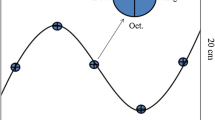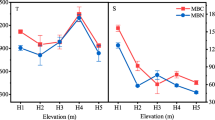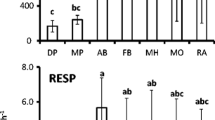Abstract
The effect of long-term elevated soil Pb levels on soil microbiota was studied at a forest site in Norway, where the soil has been severely contaminated with Pb since the last period of glaciation (several thousand years). Up to 10% Pb (total amount, w/w) has been found in the top layer. The microbial community was drastically affected, as judged from changes in the phospholipid fatty acid (PLFA) pattern. Specific PLFAs that were high in Pb-enriched soil were branched (especially br17:0 and br18:0), whereas PLFAs common in eukaryotic organisms such as fungi (18:2ω6,9 and 20:4) were low compared with levels at adjacent, uncontaminated sites. Congruent changes in the PLFA pattern were found upon analyzing the culturable part of the bacterial community. The high Pb concentrations in the soil resulted in increased tolerance to Pb of the bacterial community, measured using both thymidine incorporation and plate counts. Furthermore, changes in tolerance were correlated to changes in the community structure. The bacterial community of the most contaminated soils showed higher specific activity (thymidine and leucine incorporation rates) and higher culturability than that of control soils. Fungal colony forming units (CFUs) were 10 times lower in the most Pb-enriched soils, the species composition was widely different from that in control soils, and the isolated fungi had high Pb tolerance. The most commonly isolated fungus in Pb-enriched soils was Tolypocladium inflatum. Comparison of isolates from Pb-enriched soil and isolates from unpolluted soils showed that T. inflatum was intrinsically Pb-tolerant, and that the prolonged conditions with high Pb had not selected for any increased tolerance.






Similar content being viewed by others
References
K Arnebrant E Bååth A Nordgren (1987) ArticleTitleCopper tolerance of microfungi isolated from polluted and unpolluted forest soil Mycologia 79 890–895 Occurrence Handle1:CAS:528:DyaL1cXhs1ClsL8%3D
E Bååth (1981) ArticleTitleMicrofungi in a clear-cut pine forest soil in central Sweden Can J Bot 59 1331–1337
E Bååth (1989) ArticleTitleEffects of heavy metals in soil on microbial processes and populations (a review) Water Air Soil Pollut 47 335–379
E Bååth (1992) ArticleTitleThymidine incorporation into macromolecules of bacteria extracted from soil by homogenization–centrifugation Soil Biol Biochem 24 1157–1165
E Bååth (1992) ArticleTitleMeasurement of heavy metal tolerance of soil bacteria using thymidine incorporation into bacteria extracted after homogenization–centrifugation Soil Biol Biochem 24 1167–1172
E Bååth (1994) ArticleTitleMeasurement of protein synthesis by soil bacterial assemblages with the leucine incorporation technique Biol Fertil Soils 17 147–153
E Bååth (1994) ArticleTitleThymidine and leucine incorporation in soil bacteria with different cell size Microb Ecol 27 267–278
E Bååth T-H Anderson (2003) ArticleTitleComparison of soil fungal/bacterial ratios in a pH gradient using physiological and PLFA-based techniques Soil Biol Biochem 35 955–963
E Bååth Å Frostegård M Díaz-Raviña A Tunlid (1998) ArticleTitleMicrobial community-based measurements to estimate heavy metal effects in soil Ambio 27 58–61
E Bååth LO Nilsson H Göransson H Wallander (2004) ArticleTitleCan the extent of degradation of soil fungal mycelium during soil incubation be used to estimate ectomycorrhizal biomass in soil? Soil Biol Biochem 36 2105–2109
H Blanck (2002) ArticleTitleA critical review of procedures and approaches used for assessing pollution-induced community tolerance (PICT) in biotic communities Hum Ecol Risk Assess 8 1003–1034
B Bølvigen J Låg (1977) ArticleTitleNatural heavy-metal poisoning of soils and vegetation: an exploration tool in glaciated terrain Appl Earth Sci Trans Sect B 86 173–180
M Díaz-Raviña E Bååth (1996) ArticleTitleThymidine and leucine incorporation into bacteria from soils experimentally contaminated with heavy metals Appl Soil Ecol 3 225–234
F Ekelund S Olsson A Johansen (2003) ArticleTitleChanges in the succession and diversity of protozoan and microbial populations in soil spiked with a range of copper concentrations Soil Biol Biochem 35 1507–1516 Occurrence Handle10.1016/S0038-0717(03)00249-9 Occurrence Handle1:CAS:528:DC%2BD3sXnsVKhtrw%3D
Å Frostegård E Bååth (1996) ArticleTitleThe use of phospholipid fatty acid analysis to estimate bacterial and fungal biomass in soil Biol Fertil Soils 22 59–65
Å Frostegård A Tunlid E Bååth (1993) ArticleTitlePhospholipid fatty acid composition, biomass and activity of microbial communities from two soil types experimentally exposed to different heavy metals Appl Environ Microbiol 59 3605–3617 Occurrence Handle16349080
KE Giller E Witter SP McGrath (1998) ArticleTitleToxicity of heavy metals to microorganisms and microbial processes in agricultural soil: a review Soil Biol Biochem 30 1389–1414 Occurrence Handle10.1016/S0038-0717(97)00270-8 Occurrence Handle1:CAS:528:DyaK1cXkslCmsbs%3D
A Grant (2002) ArticleTitlePollution-tolerant species and communities: intriguing toys or invaluable monitoring tools? Human Ecol Risk Assess 8 955–970
J Låg OØ Hvatum B Bølvigen (1969) ArticleTitleAn occurrence of naturally lead-poisoned soil at Kastad near Gjøvik, Norway Nor Geol Surv 266 141–159
M Khan J Scullion (2000) ArticleTitleEffect of soil on microbial responses to metal contamination Environ Pollut 110 115–125 Occurrence Handle15092861 Occurrence Handle10.1016/S0269-7491(99)00288-2 Occurrence Handle1:CAS:528:DC%2BD3cXksFyiur0%3D
M Khan J Scullion (2002) ArticleTitleEffects of metal (Cd, Cu, Ni, Pb or Zn) enrichment of sewage-sludge on soil micro-organisms and their activities Appl Soil Ecol 20 145–155 Occurrence Handle10.1016/S0929-1393(02)00018-5
GW Korthals AD Alexiev TM Lexmond JE Kammenga T Bongers (1996) ArticleTitleLong-term effects of copper and pH on the nematode community in an agroecosystem Environ Toxicol Chem 15 979–985 Occurrence Handle10.1897/1551-5028(1996)015<0979:LTEOCA>2.3.CO;2 Occurrence Handle1:CAS:528:DyaK28Xjtl2itbc%3D
WL Lindsay WA Norvell (1978) ArticleTitleDevelopment of a DTPA test forzinc, iron, manganese and copper Soil Sci Soc Am J 42 421–428 Occurrence Handle1:CAS:528:DyaE1cXltVKntLs%3D Occurrence Handle10.2136/sssaj1978.03615995004200030009x
AK Müller K Westergaard S Christensen SJ Sørensen (2001) ArticleTitleThe effect of long-term mercury pollution on the soil microbial community FEMS Microbiol Ecol 36 11–19 Occurrence Handle11377769
A Nordgren B Söderström E Bååth (1983) ArticleTitleMicrofungi and microbial activity along a heavy metal gradient Appl Environ Microbiol 45 1829–1837 Occurrence Handle16346316 Occurrence Handle1:CAS:528:DyaL3sXks1Ohtro%3D
T Pennanen (2001) ArticleTitleMicrobial communities in boreal coniferous forest humus exposed to heavy metals and changes in soil pH—a summary of the use of phospholipid fatty acids, Biolog® and 3H-thymidine incorporation methods in field studies Geoderma 100 91–126 Occurrence Handle10.1016/S0016-7061(00)00082-3 Occurrence Handle1:CAS:528:DC%2BD3MXpsVGhsA%3D%3D
T Pennanen H Fritze P Vanhala O Kiikkilä S Neuvonen E Bååth (1998) ArticleTitleStructure of a microbial community in soil after prolonged addition of low levels of simulated acid rain Appl Environ Microbiol 64 2173–2180 Occurrence Handle9603831 Occurrence Handle1:CAS:528:DyaK1cXjslWhsbY%3D
T Pennanen Å Frostegård H Fritze E Bååth (1996) ArticleTitlePhospholipid fatty acid composition and heavy metal tolerance of soil microbial communities along two heavy metal-polluted gradients in coniferous forests Appl Environ Microbiol 62 420–428 Occurrence Handle1:CAS:528:DyaK28XovVCmug%3D%3D Occurrence Handle16535230
RMCP Rajapaksha MA Tobor-Kapłan E Bååth (2004) ArticleTitleMetal toxicity affects fungal and bacterial activities in soil differently Appl Environ Microbiol 70 2966–2973 Occurrence Handle15128558 Occurrence Handle10.1128/AEM.70.5.2966-2973.2004 Occurrence Handle1:CAS:528:DC%2BD2cXktlCntr8%3D
G Renella AM Chaudri PC Brookes (2002) ArticleTitleFresh additions of heavy metals do not model long-term effects on microbial biomass and activity Soil Biol Biochem 34 121–124 Occurrence Handle1:CAS:528:DC%2BD38XksVaj
KH Söderberg PA Olsson E Bååth (2002) ArticleTitleStructure and activity of the bacterial community in the rhizosphere of different plant species and the effect of arbuscular mycorrhizal colonization FEMS Microbiol Ecol 40 223–231 Occurrence Handle19709230
KH Söderberg A Probanza A Jumpponen E Bååth (2004) ArticleTitleThe microbial community in the rhizosphere determined by community-level physiological profiles (CLPP) and direct soil- and cfu-PLFA techniques Appl Soil Ecol 25 135–145
B Söderström E Bååth (1978) ArticleTitleSoil microfungi in three Swedish coniferous forests Holarct Ecol 1 62–72
P Beelen ParticleVan P Doelman (1997) ArticleTitleSignificance and application ofmicrobial toxicity tests in assessing ecotoxicological risks ofcontamination in soil and sediment Chemosphere 34 455–499
H Yamamoto K Tatsuyama T Uchiwa (1985) ArticleTitleFungal flora of soil polluted with copper Soil Biol Biochem 17 785–790 Occurrence Handle1:CAS:528:DyaL28XltVOm
L Zelles (1997) ArticleTitlePhospholipid fatty acid profiles in selected members of soil microbial communities Chemosphere 35 275–294 Occurrence Handle9232001 Occurrence Handle10.1016/S0045-6535(97)00155-0 Occurrence Handle1:CAS:528:DyaK2sXksFCiurg%3D
Acknowledgments
This study was supported by grants from the Ministerio Español de Educación y Ciencia to M.D.-R. and from the Swedish Research Council to E.B.
Author information
Authors and Affiliations
Corresponding author
Rights and permissions
About this article
Cite this article
Bååth, E., Díaz-Raviña, M. & Bakken, L.R. Microbial Biomass, Community Structure and Metal Tolerance of a Naturally Pb-Enriched Forest Soil. Microb Ecol 50, 496–505 (2005). https://doi.org/10.1007/s00248-005-0008-3
Received:
Accepted:
Published:
Issue Date:
DOI: https://doi.org/10.1007/s00248-005-0008-3




